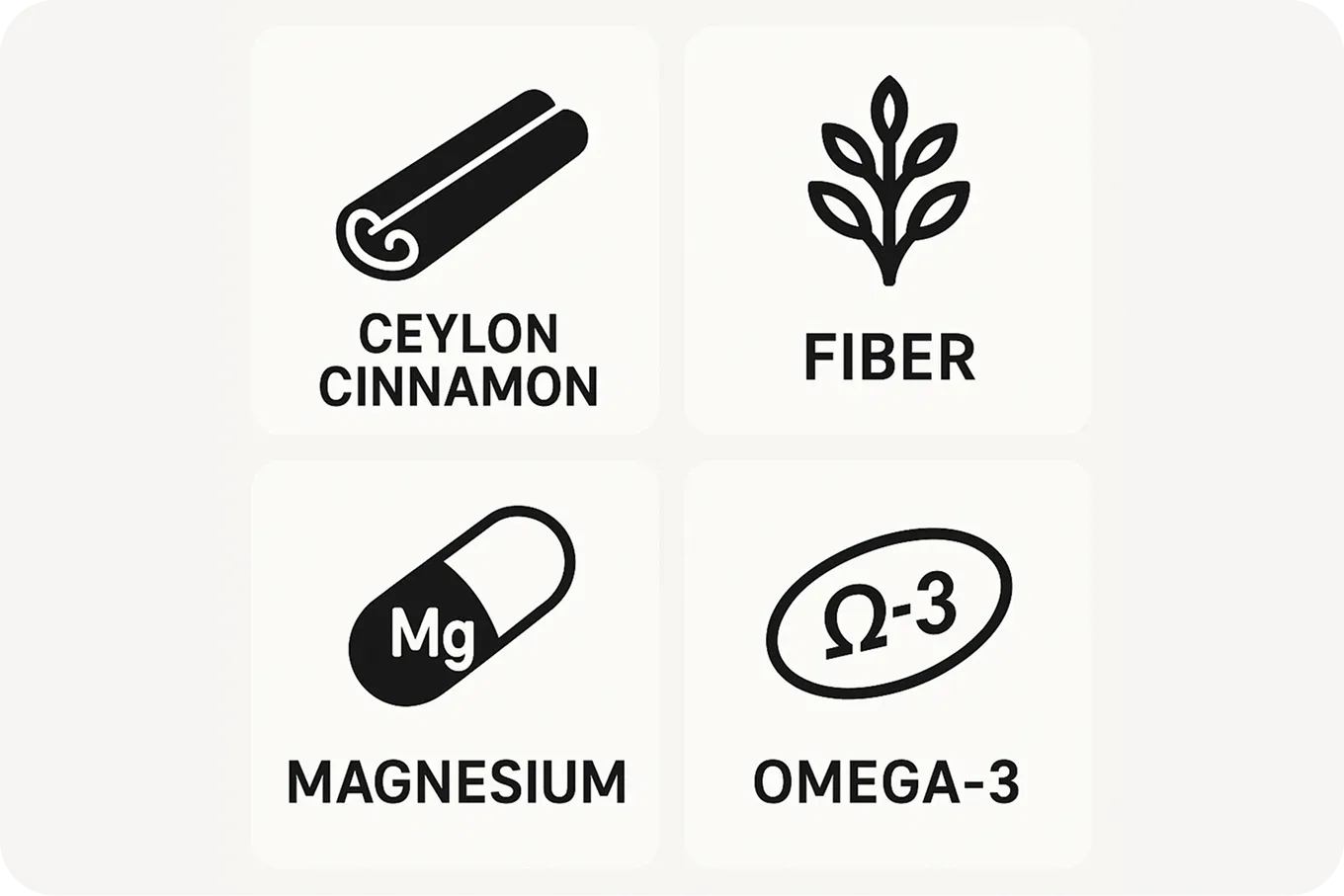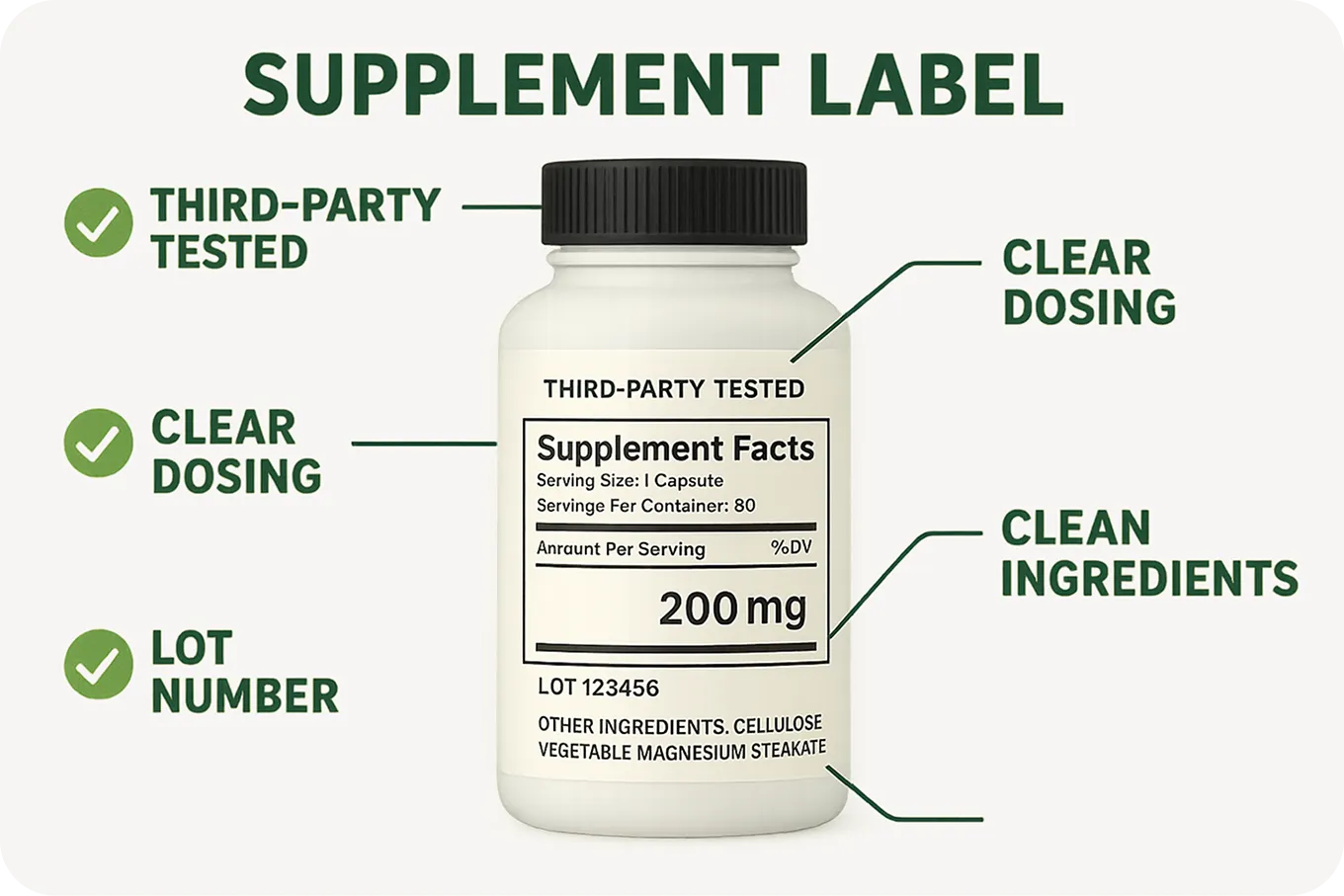How to Take Berberine: Dosage, Timing, Cycling & Stacks (A Practical Guide)
High-trust buyer’s-guide-style piece that teaches readers exactly how to evaluate quality and avoid common pitfalls.
By Supplement Reports Team
August 21, 2025
16 min read



60-Second Summary

Berberine is a powerful natural compound that supports metabolic health, but maximizing its benefits requires understanding the nuances of proper usage. This comprehensive guide provides practical, evidence-based information on how to take berberine effectively, covering everything from optimal serving sizes and timing to advanced cycling strategies and synergistic supplement combinations. We’ll explore the science behind dosing recommendations,
examine different approaches to timing and frequency, discuss quality considerations that can make or break your results, and provide detailed guidance on building effective supplement stacks. Whether you’re new to berberine or looking to optimize your current regimen, this guide will help you develop a personalized approach that maximizes benefits while minimizing potential side effects.
The most critical factors for berberine success are consistent timing with meals, gradual dose escalation to minimize side effects, and understanding that berberine works best as part of a comprehensive approach to metabolic health that includes proper nutrition and regular physical activity. Most people find optimal results with 900-1500mg daily, divided into 2-3 doses taken with meals, but individual needs can vary significantly based on factors like body weight, metabolic status, and specific health goals.
Understanding Berberine: The Foundation for Effective Use

Berberine has what researchers call ‘poor oral bioavailability,’ meaning that only a small percentage of what you consume actually reaches your bloodstream in an active form. Studies suggest that berberine’s bioavailability ranges from just 0.5% to 5%, depending on various factors including the form of berberine, what it’s taken with, and individual digestive characteristics.
This low bioavailability isn’t necessarily a problem—it’s simply a characteristic that needs to be accounted for in dosing strategies. The berberine that does get absorbed appears to be highly effective at reaching target tissues and exerting its beneficial effects. Additionally, some of berberine’s benefits may come from its actions in the digestive tract before absorption, including its effects on gut microbiota and intestinal glucose absorption.
The compound’s half-life in the body is relatively short, typically ranging from 2-4 hours. This means that berberine levels in your system drop relatively quickly after taking it, which is why most effective protocols involve multiple daily doses rather than a single large dose.
Berberine’s primary mechanism of action involves the activation of AMPK (AMP-activated protein kinase), often called the body’s ‘master metabolic switch.’ This enzyme plays a crucial role in cellular energy homeostasis, and its activation triggers a cascade of metabolic changes that can support healthy glucose and lipid metabolism. Understanding this mechanism helps explain why berberine is most effective when taken consistently over time rather than sporadically.
Serving Size Fundamentals: Finding Your Optimal Dose

For beginners, starting at the lower end of this range is generally advisable. A typical starting protocol might involve 300mg taken twice daily with meals, providing a total daily intake of 600mg. This conservative approach allows your body to adapt to berberine gradually while minimizing the risk of gastrointestinal side effects that can occur when starting with higher doses.
After 1-2 weeks at the starting dose, you can gradually increase to the standard therapeutic range. A common progression involves increasing to 300mg three times daily (900mg total) for another 1-2 weeks, then potentially increasing to 500mg twice daily (1000mg total) if additional benefits are desired and the lower doses are well-tolerated.
Individual factors can influence optimal dosing. Body weight plays a role, with larger individuals often requiring higher doses to achieve similar effects. Metabolic status is another consideration—people with more significant metabolic challenges may benefit from doses at the higher end of the range, while those using berberine for general metabolic support might find lower doses sufficient.
The timing of dose increases is important for both effectiveness and tolerability. Rushing to higher doses can increase the likelihood of side effects and may actually reduce compliance with your supplementation routine. Taking time to assess your response at each dose level allows you to find the minimum effective dose for your individual needs.
Timing Strategies: When and How to Take Berberine

The ‘with meals’ recommendation isn’t just about taking berberine at the same time you eat—it’s about optimizing the interaction between the supplement and your digestive processes. Taking berberine 15-30 minutes before eating can be particularly effective, as this timing allows the compound to be present in your system as your body begins processing the incoming nutrients.
For those following a standard three-meal-per-day eating pattern, the most common and effective approach involves taking berberine with breakfast, lunch, and dinner. This provides consistent coverage throughout the day and aligns with your body’s natural circadian rhythms of glucose and lipid metabolism.
The size and composition of meals can influence berberine’s effectiveness. Larger meals, particularly those containing carbohydrates, create a greater metabolic challenge that berberine can help address. However, berberine can be beneficial with any substantial meal, regardless of macronutrient composition.
Consistency in timing is more important than perfect timing. If your schedule makes it difficult to take berberine at exactly the same times each day, focus on maintaining the pattern of taking it with meals rather than worrying about precise clock times. Your body’s metabolic rhythms are more closely tied to eating patterns than to specific times of day.
Advanced Timing Considerations for Different Lifestyles

For individuals following intermittent fasting protocols, berberine timing requires special consideration. Since berberine is most effective when taken with food, those practicing extended fasting periods may need to concentrate their berberine intake during their eating windows.
A common approach involves taking the full daily dose split between the first and last meals of the eating window. Some intermittent fasting practitioners find that taking a small dose of berberine (100-200mg) during their fasting period can help maintain stable energy levels without significantly impacting the fast. However, this approach should be used cautiously and may not be suitable for everyone, particularly those new to either berberine or intermittent fasting.
Shift workers and those with irregular schedules face unique challenges in maintaining consistent berberine timing. The key principle remains taking berberine with substantial meals, but the specific timing may need to be adjusted based on work schedules and sleep patterns. The most important factor is maintaining consistency in the timing relative to your meals and sleep cycle, even if the actual clock times vary.
Athletes and highly active individuals may benefit from strategic timing around training sessions. Some research suggests that berberine’s AMPK-activating effects might complement exercise-induced metabolic changes. Taking berberine with a pre-workout meal (2-3 hours before training) or with the first post-workout meal can potentially enhance these synergistic effects.
For people with digestive sensitivities, the timing relative to meals becomes even more critical. Taking berberine with larger, more substantial meals can help buffer its effects on the digestive system. Some individuals find that taking berberine in the middle of a meal, rather than before or after, provides the best balance of effectiveness and tolerability.
Cycling Strategies: When and Why to Take Breaks

Current research suggests that berberine doesn’t appear to cause significant tolerance or adaptation that would necessitate cycling for continued effectiveness. Studies lasting 3-12 months have shown sustained benefits without evidence of diminishing returns. The compound’s mechanism of action through AMPK activation appears to remain consistent with continued use.
However, some practitioners and users report benefits from periodic cycling, not necessarily because berberine stops working, but because breaks can provide opportunities to assess the supplement’s ongoing value and make adjustments to the overall health regimen. A common cycling approach involves 8-12 weeks of consistent use followed by a 2-4 week break.
During cycling breaks, it’s important to maintain the lifestyle factors that support metabolic health—proper nutrition, regular exercise, adequate sleep, and stress management. The break period can serve as a test of how well these foundational elements are supporting your metabolic health independent of supplementation.
Some individuals choose to cycle berberine seasonally, using it during periods when metabolic challenges might be greater (such as during holidays or periods of increased stress) and taking breaks during times when lifestyle factors are more optimal. This approach can be particularly useful for people who use berberine primarily for metabolic support rather than addressing specific health concerns.
Building Effective Stacks: Complementary Supplements

The most synergistic additions to berberine are compounds that work through complementary mechanisms or enhance berberine’s absorption and effectiveness. Ceylon cinnamon, as discussed in our companion article, represents one of the most well-researched and effective combinations with berberine.
Chromium picolinate (200-400mcg daily) is another highly complementary addition. Chromium plays crucial roles in carbohydrate and lipid metabolism, and research suggests it may enhance insulin sensitivity through mechanisms that complement berberine’s AMPK activation. The timing for chromium can align with berberine doses, taken with meals.
Alpha-lipoic acid (ALA) at 300-600mg daily provides both antioxidant support and additional metabolic benefits that work synergistically with berberine. ALA is unique in being both water- and fat-soluble, allowing it to provide comprehensive cellular protection. For optimal absorption, ALA is best taken on an empty stomach, which means timing it between meals rather than with berberine.
Magnesium glycinate (200-400mg daily) can provide foundational support for the hundreds of enzymatic reactions that depend on adequate magnesium levels, many of which relate to glucose and energy metabolism. Magnesium can be taken with berberine doses or separately, depending on individual tolerance and preferences.
Omega-3 fatty acids from fish oil (1-2g EPA/DHA daily) complement berberine’s metabolic effects by supporting healthy inflammation responses and cellular membrane function. The timing of omega-3 supplementation is flexible, but taking it with meals that contain some fat can enhance absorption.
When building a berberine stack, introduce new supplements one at a time, allowing 1-2 weeks to assess individual responses before adding the next component. This systematic approach helps you identify which combinations work best for your individual needs and allows you to adjust dosing or timing as needed.
Quality and Form Considerations: Maximizing Your Investment

Berberine hydrochloride (berberine HCl) represents the gold standard for berberine supplementation. This form offers superior stability, solubility, and bioavailability compared to crude plant extracts or other berberine salts. When examining product labels, look for clear identification of ‘berberine hydrochloride’ or ‘berberine HCl’ rather than vague terms like ‘berberine complex’ or proprietary blends that don’t specify the actual berberine content.
Third-party testing represents one of the most important quality indicators for berberine supplements. Reputable manufacturers will provide certificates of analysis (COAs) that verify the product’s purity, potency, and freedom from contaminants. These documents should be easily accessible, either through QR codes on the packaging or through the manufacturer’s website.
The testing should include verification of berberine content (potency testing), screening for heavy metals, microbial contaminants, and residual solvents. Look for products that meet or exceed established safety standards for these potential contaminants.
Manufacturing standards also play a crucial role in product quality. Look for supplements produced in facilities that follow Good Manufacturing Practices (GMP) and are registered with the FDA. Some manufacturers go beyond basic requirements by obtaining additional certifications like NSF International or USP verification.
Packaging and storage considerations can affect berberine’s stability and potency. Look for products packaged in dark, airtight containers that protect against light and moisture. Avoid products that have been exposed to extreme temperatures or have passed their expiration dates.
Managing Side Effects and Optimizing Tolerance

Gastrointestinal effects represent the most common side effects associated with berberine use. These can include mild stomach upset, changes in bowel movements (either loose stools or constipation), and occasional nausea. These effects are typically dose-dependent and more likely to occur when starting berberine or increasing doses rapidly.
The most effective strategy for minimizing gastrointestinal side effects involves gradual dose escalation and consistent timing with meals. Starting with 300mg once or twice daily and increasing slowly over 2-3 weeks allows your digestive system to adapt gradually. Taking berberine with substantial meals, rather than light snacks, provides better buffering and reduces the likelihood of stomach upset.
Some people find that taking berberine in the middle of a meal, rather than before or after, provides the best balance of effectiveness and tolerability. This timing ensures that the berberine is mixed with food throughout the digestive process, which can help minimize direct contact with sensitive stomach lining.
Staying well-hydrated can also help minimize side effects, particularly constipation that some people experience with berberine. Adequate fiber intake from whole foods can support healthy digestion and may reduce the likelihood of digestive side effects.
If side effects persist despite these strategies, consider reducing the dose temporarily and increasing more gradually, or splitting doses into smaller, more frequent amounts taken with meals or substantial snacks throughout the day.
Monitoring Progress and Adjusting Your Protocol

Subjective measures provide valuable insights into how berberine is affecting your daily experience. Keep track of energy levels throughout the day, particularly noting any changes in post-meal energy dips or overall vitality. Many berberine users report more stable energy levels and reduced cravings for sugary foods, which can be important indicators of the supplement’s effectiveness.
Sleep quality and recovery can also provide insights into berberine’s effects. Some users report improved sleep quality, possibly related to better metabolic stability throughout the night. Others may notice changes in exercise recovery or overall physical resilience.
Digestive health is another important area to monitor, both for side effect management and as an indicator of overall metabolic health. Changes in digestion, bowel regularity, or digestive comfort can provide feedback about how well your current protocol is working.
For those working with healthcare providers, objective measures can provide more precise feedback on berberine’s effects. Regular monitoring of relevant biomarkers can help track progress and guide protocol adjustments. However, it’s important to work with knowledgeable practitioners who understand berberine’s effects and can interpret changes in the context of your overall health picture.
Keep a simple log of your berberine usage, including doses, timing, and any notable effects or side effects. This record can help you identify patterns and make informed adjustments to your protocol over time. Note any changes in your routine, diet, exercise, or stress levels that might influence your response to berberine.
Long-term Success Strategies and Sustainability

Consistency trumps perfection when it comes to berberine supplementation. Rather than striving for perfect timing and dosing every single day, focus on developing routines that you can maintain reliably. This might mean accepting slightly suboptimal timing on busy days rather than skipping doses entirely, or adjusting your protocol during travel or schedule changes.
Building berberine supplementation into existing habits can significantly improve long-term adherence. Many successful users tie their berberine doses to established meal routines, using existing habits as anchors for the new behavior. This approach leverages the psychological principle of habit stacking, making the new behavior more automatic and sustainable.
Regular protocol reviews can help ensure your berberine supplementation continues to serve your evolving health goals. Every 3-6 months, take time to assess whether your current approach is still optimal. This might involve adjusting doses based on changes in diet, exercise, stress levels, or health status. It could also mean experimenting with different timing strategies or complementary supplements based on new research or changing goals.
Flexibility in your approach allows for adaptation to changing circumstances without abandoning the benefits of berberine supplementation. This might involve adjusting doses during periods of increased stress, modifying timing during travel, or temporarily simplifying your protocol during busy periods.
Remember that berberine supplementation is most effective as part of a comprehensive approach to metabolic health. Maintaining focus on the foundational elements—proper nutrition, regular physical activity, adequate sleep, and stress management—ensures that your berberine supplementation can work optimally and provides the greatest long-term benefits.
Finally, stay informed about new research and developments in berberine supplementation. The field of nutritional science is constantly evolving, and new insights about optimal usage, combinations, or applications may provide opportunities to enhance your protocol over time.
Disclaimer:
Top Rated Berberine Supplement
Berberine + Ceylon Cinnamon (1400mg formula)
9.8

- 1200 mg berberine equals 24,000 mg raw powder strength.
- Enhanced with Ceylon cinnamon extract for antioxidant and wellness support.
- Absorption boosted by MCT oil, Alpha-GPC, phosphatidylcholine blend.
- Promotes steady energy, focus, clarity without caffeine or stimulants.
- Manufactured in USA, purity tested, GMP-certified quality supplement.
Show more
- 1200 mg berberine equals 24,000 mg raw powder strength.
- Enhanced with Ceylon cinnamon extract for antioxidant and wellness support.
- Absorption boosted by MCT oil, Alpha-GPC, phosphatidylcholine blend.
- Promotes steady energy, focus, clarity without caffeine or stimulants.
- Manufactured in USA, purity tested, GMP-certified quality supplement.
Picked by ... people today
